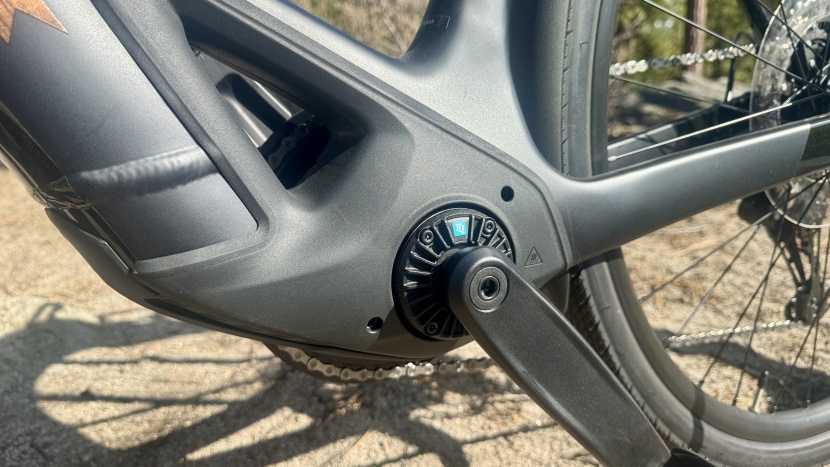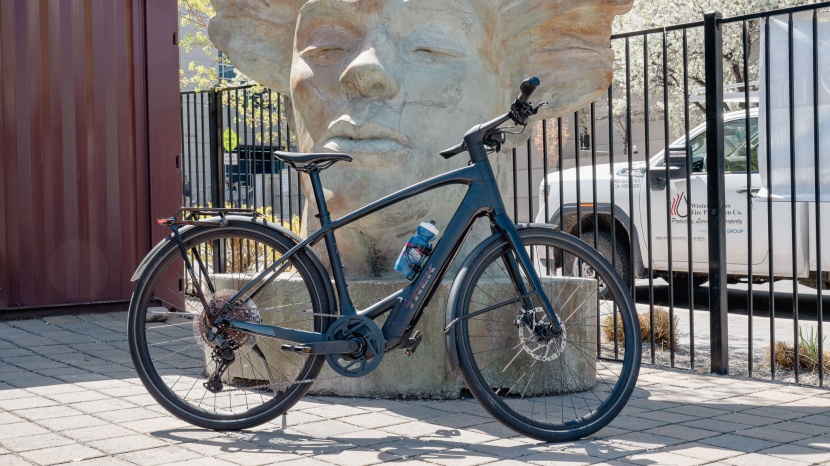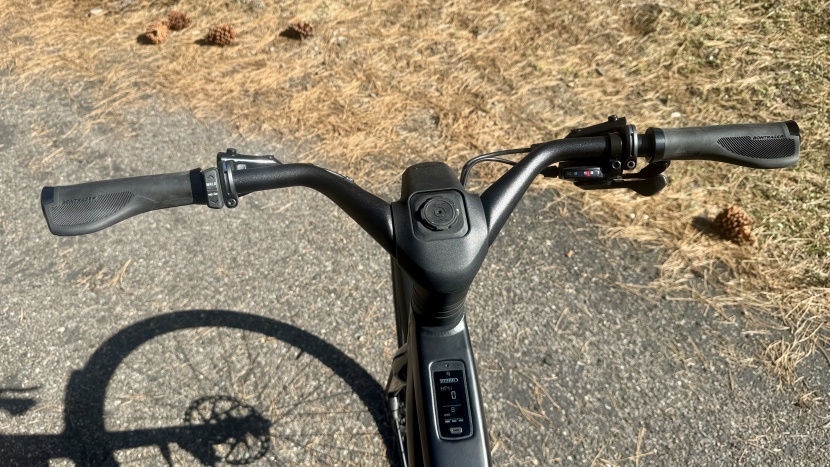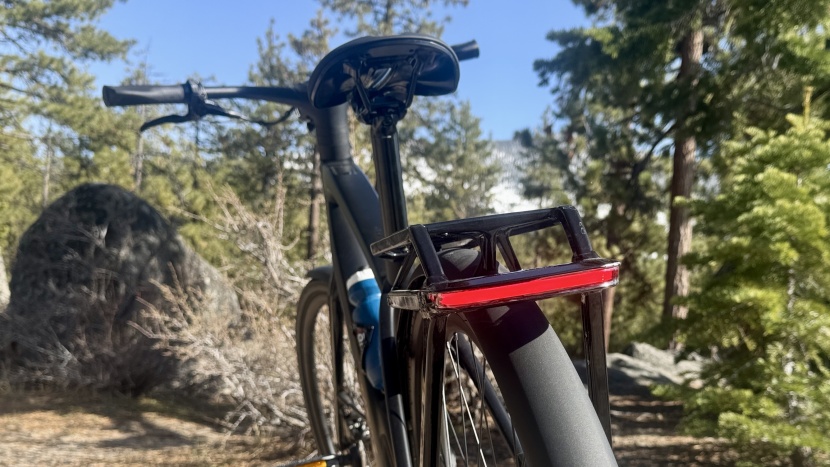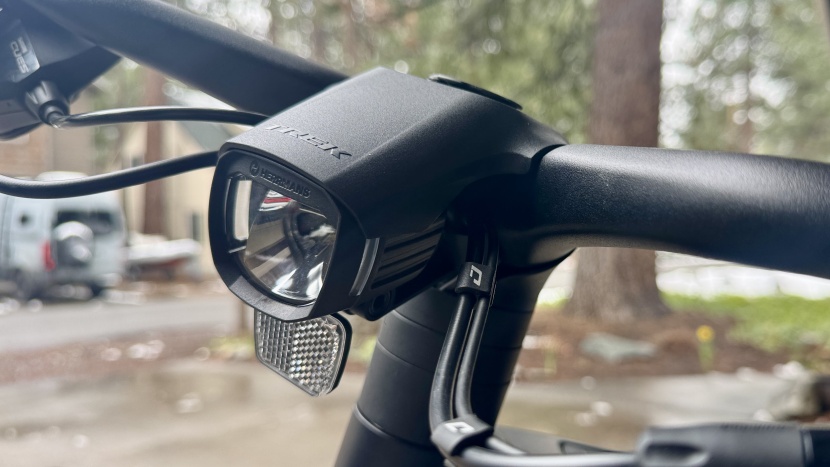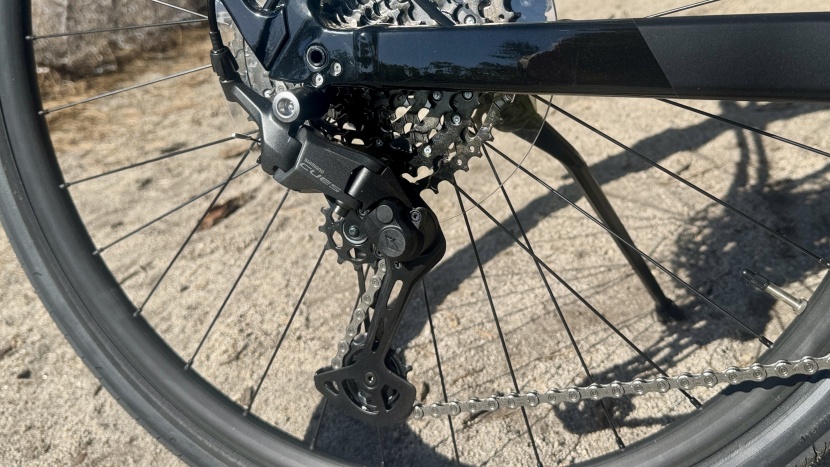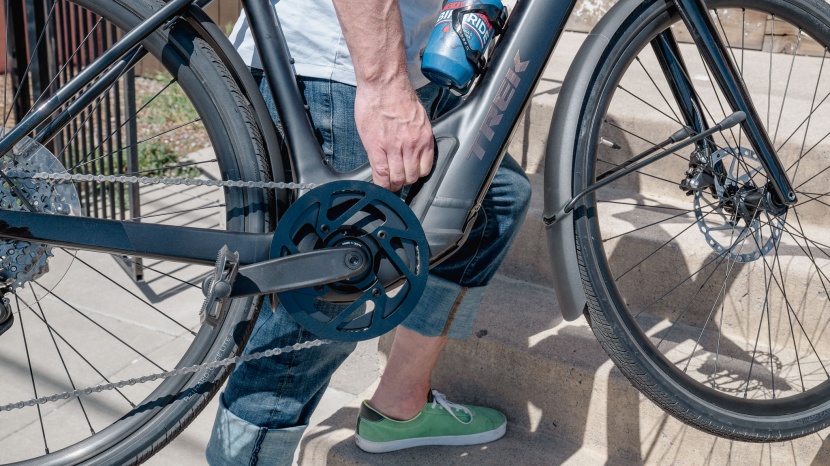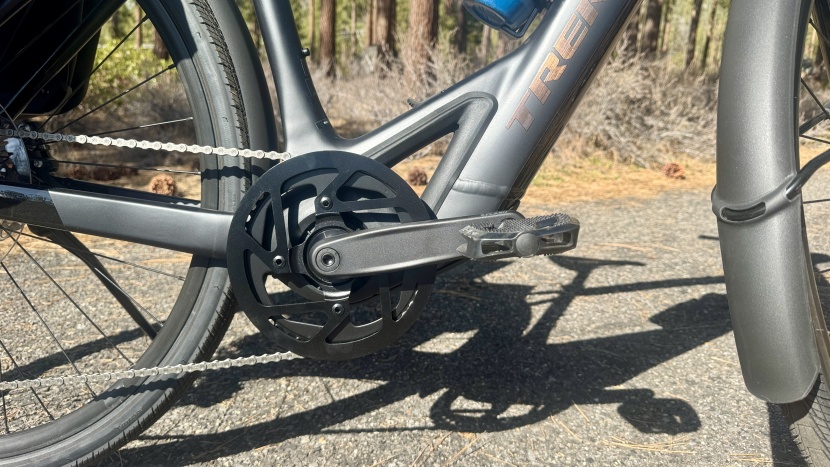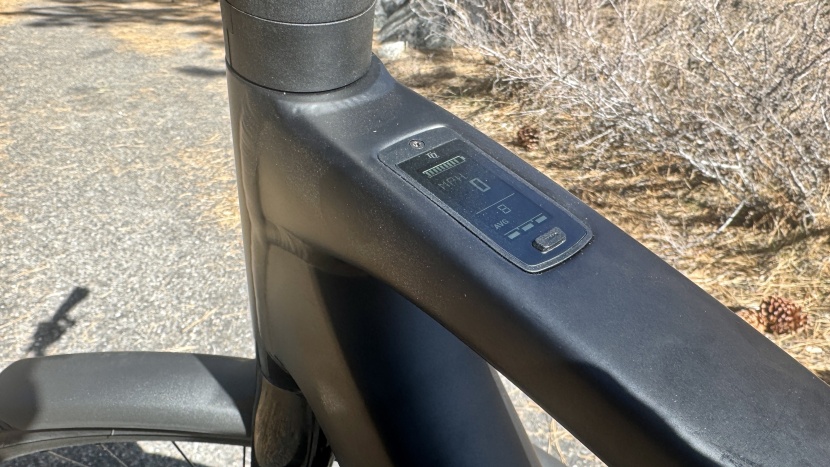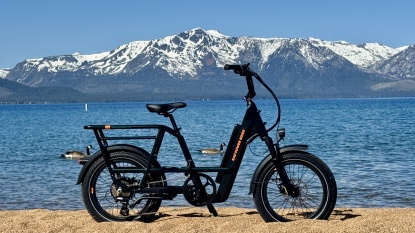
Our Verdict
Our Analysis and Test Results
Trek Bicycles is a powerhouse in the bicycle industry with a huge number of successes in almost every category. The FX+7S is their latest take on an electric commuter bike with a compact TQ-HPR50 motor. The motor uses a harmonic pin ring transmission to provide a quiet, subtle assist and a compact battery, leaving the bike slightly heavier than a non-electric commuter. The FX+7S is a Class 3 bike that won't wow you with its power, but it can subsidize the power from your legs enough to leave you feeling fresh.
Ride
The FX+7S is built on an Alpha aluminum frame with a carbon fork. The bike rolls on 700c wheels using 42mm tires and doesn't look remarkably different than a standard hybrid bike. A compact mid-drive motor provides up to 250 watts of assistance and hides at the bottom of the bike's downtube. Inside the downtube is a 360Wh battery, weighing about half (1800 grams) of what most ebike batteries weigh. While this inevitably results in less range, the bike is lighter and far easier to manage without the extra mass.
The double-diamond frame has an additional tube connecting the bottom of the downtube and seat tube that can be used as a handle, but its ride quality is fairly conventional. Trek gave the bike a 71-degree headtube angle, which provides quick handling and an agile feel. The frame has a 74.6-degree seat tube angle, which is a fair bit steeper than bikes of yesteryear and puts the rider directly above the bottom bracket for optimal power transfer. Our Large test bike has a step-over height of 790mm and a wheelbase of 1080mm. Nothing is surprising or revolutionary about these numbers; those with a shorter inseam may want to measure twice, as the top tube curves slightly upward and may impede some people from standing over the top tube. The wheelbase is long enough that our feet didn't contact the front wheel in slow corners, and the bike feels stable at faster speeds.
The aluminum frame is lightweight but also stiff, so it doesn't provide much vibration dampening. In fact, the entire bike feels rigid with an alloy seatpost, steerer tube, and handlebar; the only dampening comes from the 42mm tires and carbon fork legs. The flipside to this rigidity is that the bike is lightweight and responsive. The sweptback “swallow-style” handlebar is integrated with the stem, so the front end has very little adjustability. Fortunately, we found the handlebars to be quite comfortable for extended rides. The integrated stem pushes the 680mm handlebar out 90mm from the steerer tube, and the handlebars have 15mm of rise.
Since this is a Class 3 e-bike with a mid-drive motor, there is no throttle, and the cockpit is clean and clutter-free, save for the quad-lock phone mount on the stem. The integrated phone mount securely holds your phone and charges it wirelessly while you ride. You can purchase an aftermarket quad-lock phone case or use the adhesive quadlock adapter that Trek provides. Hydraulic disc brakes and a single shifter populate the areas near the grips, along with a wired two-button controller for the motor. On the bottom of the stem is an integrated Herrmans H-Black MR9-E headlight that provides 190 lumens to brighten your path.
The ride quality is responsive and exceptionally good on smooth pavement, but somewhat unforgiving on less smooth surfaces. Riding the bike with the power turned off, you can barely tell it's an ebike. A 10-speed drivetrain with a wide-range 11-48 cassette gives you ample gearing for steep hills and faster speeds. When you power the bike on, you can choose from 3 support settings: ECO, MID, and HIGH. The motor's assistance is among the smoothest and most subtle of any e-bike we've ridden. The TQ-motor is near silent, and its assistance can be mistaken for a tailwind half the time. If you've been riding a more powerful e-bike, you might be spoiled by the amount of assistance. The FX+7S never feels like it's doing the riding for you, but it does take the strain out of the hills and starts. The power in ECO and MID is so subtle and gentle that it's easy to forget you're riding an e-bike. In HIGH power mode, the torque is noticeable, and the bike has a sportier disposition.
The bike's controls are simple, with nice-feeling Shimano RS600 brake levers and a Cues 10-speed trigger shifter. The brakes connect with a 160mm rotor in the rear and a 180mm up front, giving the bike as much stopping power as the narrow-ish tires can handle. Large, ergonomic grips give your palms a wide surface to rest on, and the cockpit looks decidedly modern. A Cues U6000 derailleur handled the shifting duties and performed flawlessly for us.
As a commuter bike, the bike is well-honed for the task with an upright position and efficient geometry. Just how upright you will be depends on the length of your legs and the frame size you choose. I rode the bike in crowded urban spaces, bike lanes, congested intersections, and wide open roads. Throughout the varied terrain, I always felt like my visibility and position were solid and uncompromised. The bike is agile and light enough to move quickly and change directions in a flash, even when riding unpowered. The alloy rear rack is MIK compatible and houses a tail light in the rear of the structure. The headlight and taillight run off of the bike's large battery pack and continue to work when the battery reads 0% charge. The bike uses custom ABS fenders that are quiet, lightweight, and effective. I love how sleek the fenders are integrated with very little exposed hardware and a custom shape to match the crown of the fork.
The FX+7S is available in 4 sizes for riders between 5'1" and 6'6". Our size Large test bike was ideal for our 5'10" tester with an average inseam. Those with a shorter inseam could benefit from Trek's Mid-step frame design, which is essentially a step-through design that puts the top tube 10-20cm lower, depending on the size. Both bikes benefit from the cleverly placed handle above the bottom bracket, and the low weight makes carrying the bike up stairs or over an obstacle a possibility.
Range
We generally use an e-bike's throttle to test range, but the FX+7S, a Class 3 bike, does not have a throttle. To activate the motor, we need to trigger the bike's torque sensor, which can only be done by pedaling. To assess this and other throttleless bikes, we use a set of Garmin power meter pedals connected to a Garmin 830 head unit to monitor our real-time power input. We then pedal the bike just enough to activate the motor, which typically produces about 100 watts, and attempt to maintain a constant wattage throughout the ride.
Trek makes very few claims about the bike's range, but we had pretty low expectations given its 360Wh battery and motor that can generate 300 watts of peak power. Our 180-pound test rider was able to ride the bike 15.4 miles with just under 900 feet of elevation gain before the battery was depleted. We had a fully charged phone plugged into the quad-lock charger and were using the Trek Central App. As a result, there was a small drain on the bike's battery to keep our phone running, but this should require minimal wattage. The app features excellent graphics, displays a high-quality map, includes a power meter reading, and shows you how much power the TQ motor contributes. I found the app much more engaging and informative than the simple screen on the toptube. While range testing, I watched the screen of my Garmin power meter and compared the power readings, and I found Trek's numbers to be very accurate. The app also shows your remaining range as a percentage of battery and the number of miles you can ride in your current setting. The app told me I had single digits of mileage left and 18% battery remaining when the battery died. I was initially confused until I saw the 0% battery remaining on the TQ screen. So while the app is spectacular in many ways, it may convey less than reliable range information. Those looking for additional range can add an extender that gives the bike 44% more range from a water bottle-shaped 160Wh battery.
Power
The TQ-HPR50 provides 50 Nm of torque and 250 watts of maximum continuous rated power, bumping up to 300 watts for peak power. In contrast, some of the commuter ebikes we've tested put out up to 1300 watts at peak power, so the Trek feels much less powerful in comparison. That said, the bike is less than half the weight of some of our most powerful e-commuters. While the bike has significantly less power than most, this isn't the end of the story. The “tiny but mighty” TQ motor delivers incredibly smooth assistance that integrates better than any other motor (hub or mid-drive) we've tested. I was wowed by the feel of the motor on the Trek Fuel EXe, and Trek brings that feeling over to the commuter side.
Three levels of pedal assist are fully tunable, allowing you to adjust the Maximum power, Assist Level, and Pedal response timing. The motor's torque sensor detects the force applied to the pedals and proportionally adds power for stress-free riding. The power in each setting can be adjusted from 30- 300W, while the assist factor is tunable from 25 to 200%. This means that your input is multiplied by the assist factor. For example, if you're putting in 100 watts and have the assist factor at 150%, the motor will add 150 watts. Tuning the pedal response refers to how quickly the bike reacts to its engagement. A quick pedal response gets you up to speed right away, while a slower response allows you to produce the initial torque, and the bike eases into its assist.
Interface
The FX+7S uses a flush-mounted screen in the top tube to relay the most critical ride data. The small non-color display measures just 21 x 43mm and gives you information like your current ride mode, speed, and the battery's state of charge. The power button is at the bottom of this screen, and powering the bike on/off requires a long push. The TQ display has ANT+ and Bluetooth connectivity, allowing you to connect other devices that will show up in your Trek Central App.
A small wired remote on the left side of the handlebar allows you to switch ride modes, and the power button can be used to change your view. A long push of the (-) button activates walk mode, which lets the bike power itself at walking speed, enabling you to walk next to it without pushing. This can be a handy feature in steep situations. While the simple top tube screen works perfectly fine, using the Trek Central App opens up an entire world of useful tech integration. Putting a phone mount on your handlebars is nothing new, and even having a USB port to plug your phone in is relatively common on bikes, but having a quad-lock wireless charger built in is awesome. When your phone is receiving power, the screen stays on, allowing you to use the screen you already have for ride metrics, navigation, and even playing music if that's your thing.
The battery is completely housed in the bike's downtube and should only be removed by a Trek dealer. The 360Wh battery charges through a port on the top of the downtube. It's an easy location to reach and is protected from debris by its orientation and a rubber cover. The bike and battery are UL 2849 certified.
The charger has a 4 amp output, meaning you can fully charge a battery in 2.5 hours. While it's unfortunate that the battery isn't removable for charging off the bike, you can do that with the optional range extender, which charges in just over an hour.
Assembly
Since Trek bikes are sold through their vast dealer network, assembly duties fall on the professionals, and you simply need to pick the bike up. While this undoubtedly adds to the cost of the bike, it's nice to be able to see the bike in person and test ride it before purchasing. I picked the bike up from a local dealer, was given the owner's manual, and a 5-minute speech about the basic workings of the bike. It's refreshingly efficient, and I found the local bike shop a wealth of information.
Should You Buy the Trek FX+7S?
I found the Trek FX+7S to be adept at general commuting but lacking the power and range for serious hauls. This feels like the commuter e-bike for someone who doesn't want an e-bike. They don't want a heavy, cumbersome, complex machine that makes you a passive part of the propulsion in riding a bike, but they wouldn't mind getting to work a little faster and less sweaty. The bike is also not cheap, and the price has risen due to import tariffs since we started testing it. While I love that Trek sells through brick and mortar stores and has an excellent warranty, I'd be hard pressed to convince you of the bike's value proposition. If you're the type of person who appreciates the nuances of a refined ride and doesn't mind shelling out some extra dollars for a high-quality product, the FX+7S is really a joy to ride.
What Other Electric Commuter Bikes Should You Consider?
I love that this bike is so lightweight and easy to ride. In many ways, it's similar to the Ride1Up Roadster V3; the Roadster uses an inferior hub motor, but it's 1/3 the price and has slightly more range at just about the same weight. If you want power and comfort, check out the Segway Xafari. It has full suspension, high-volume tires, and more power and range than any other commuter bike we've tested. The Segway has an excellent ride quality, but it weighs more than two of these Trek commuters.



